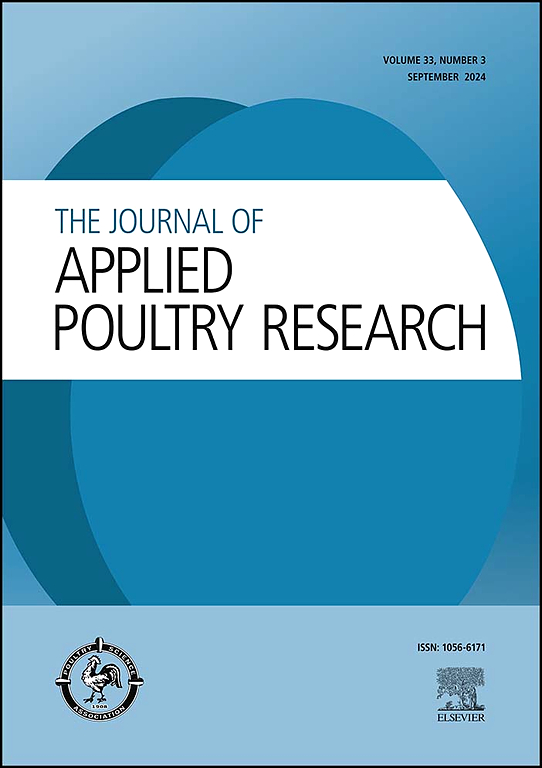与家禽和牲畜饲料相关的肠球菌的毒力分析、生物膜形成和抗菌素耐药性模式
IF 2
3区 农林科学
Q2 AGRICULTURE, DAIRY & ANIMAL SCIENCE
引用次数: 0
摘要
肠球菌是一种重要的人畜共患条件致病菌。家禽和牲畜饲料可能是肠球菌的来源。本研究旨在从畜禽饲料样品中分离鉴定粪肠杆菌和粪肠杆菌,确定它们的抗生素耐药模式,检测它们的毒力基因、耐药基因和生物膜形成能力。对84份商品饲料进行PCR筛选,其中粪肠杆菌阳性19份,粪肠杆菌阳性32份。抗生素谱结果显示,在家禽和牲畜饲料样品中,粪肠杆菌对氨苄西林的耐药性最高。在家禽饲料中,随后出现了对利福平和红霉素的耐药性,而在牲畜饲料中,又观察到对环丙沙星和氯霉素的耐药性。同样,在两种样品类型中,屎肠杆菌都对氨苄西林表现出高度耐药性。在家禽饲料中,紧随其后的是对红霉素、利福平和万古霉素的耐药,而在牲畜饲料中,紧随其后的是红霉素、四环素和其他抗生素。多数分离株的agg、pil、fsrB、fsrC等多个毒力基因阳性。基因型分析显示,大多数粪肠杆菌和从家禽和牲畜饲料分离的粪肠杆菌中均存在blaTEM基因,其中粪肠杆菌的检出率略高。在生物膜试验中,粪肠杆菌和粪肠杆菌均表现出较强的生物膜形成能力。目前的研究结果表明,形成生物膜的耐药粪肠杆菌和粪肠杆菌存在于家禽和牲畜饲料中,这可能对公共卫生产生影响。本文章由计算机程序翻译,如有差异,请以英文原文为准。
Virulence profiling, biofilm formation, and antimicrobial resistance pattern of enterococci associated with poultry and livestock feeds
Enterococcus spp. represents an important zoonotic opportunistic pathogen. Poultry and livestock feeds could be a source of Enterococci. This study aimed to isolate and identify E. faecalis and E. faecium from poultry and livestock feed samples, determine their antibiotic resistance pattern, and detect their virulence gene, resistance gene, and biofilm formation ability. Among the 84 commerciall mill origin feed samples collected, 82 were PCR screened, of which 19 were positive for E. faecalis and 32 for E. faecium. The antibiogram results revealed that E. faecalis exhibited the highest resistance to Ampicillin in both poultry and livestock feed samples. In poultry feed, this was followed by resistance to Rifampin and Erythromycin, while in livestock feed, additional resistance was observed to Ciprofloxacin and Chloramphenicol. Similarly, E. faecium showed a highresistance to Ampicillin across both sample types. In poultry feed, this was followed by resistance to Erythromycin, Rifampin, and Vancomycin, whereas in livestock feed, it was followed by Erythromycin, Tetracycline, and other antibiotics. Most isolates were positive for multiple virulent genes e.g., agg, pil, fsrB, and fsrC genes. Genotypic analysis revealed the presence of the blaTEM gene in the majority of E. faecalis and E. faecium isolates from both poultry and livestock feed, with slightly higher detection rates in E. faecalis. In the biofilm assay, both E. faecalis and E. faecium demonstrated strong biofilm-forming ability. Current findings reveal that biofilm-forming antibiotic-resistant E. faecalis and E. faecium are present in poultry and livestock feed, which could have implications for public health.
求助全文
通过发布文献求助,成功后即可免费获取论文全文。
去求助
来源期刊

Journal of Applied Poultry Research
农林科学-奶制品与动物科学
CiteScore
4.10
自引率
10.50%
发文量
80
审稿时长
104 days
期刊介绍:
The Journal of Applied Poultry Research (JAPR) publishes original research reports, field reports, and reviews on breeding, hatching, health and disease, layer management, meat bird processing and products, meat bird management, microbiology, food safety, nutrition, environment, sanitation, welfare, and economics. As of January 2020, JAPR will become an Open Access journal with no subscription charges, meaning authors who publish here can make their research immediately, permanently, and freely accessible worldwide while retaining copyright to their work. Papers submitted for publication after October 1, 2019 will be published as Open Access papers.
The readers of JAPR are in education, extension, industry, and government, including research, teaching, administration, veterinary medicine, management, production, quality assurance, product development, and technical services. Nutritionists, breeder flock supervisors, production managers, microbiologists, laboratory personnel, food safety and sanitation managers, poultry processing managers, feed manufacturers, and egg producers use JAPR to keep up with current applied poultry research.
 求助内容:
求助内容: 应助结果提醒方式:
应助结果提醒方式:


